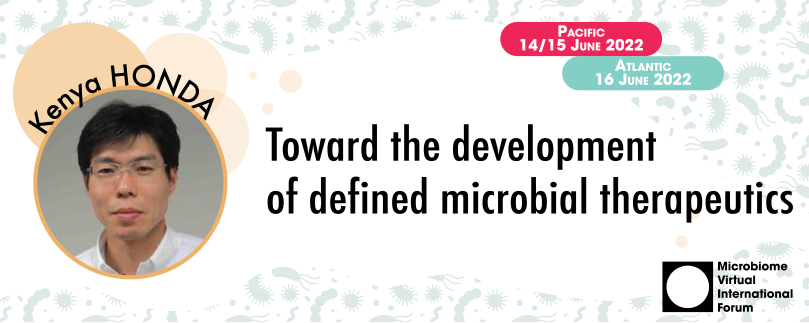Bio
Kenya Honda received his M.D. from Kobe University and his PhD from Kyoto University. He has been Assistant Professor at the Universities of Tokyo and Osaka, and is now Professor at the Department of Microbiology and Immunology at the Keio University School of Medicine in Tokyo and Team Leader of the Laboratory for Gut Homeostasis at RIKEN. He is also Scientific advisor for Vedanta Bioscience and 4Bio Capital, and an editor for a number of Journals. Prof. Honda has received a number of awards, including the NISTEP Award, the Gottfried Wagener Prize, the JSI award, the Inoue Prize for Science, the Academic Award of the Mochida Memorial Foundation, the Bäelz award, and the Carlos J. Finlay UNESCO Prize for Microbiology. From 2014 to 2021, he has been named by Clarivate Analytics in the list of “Highly Cited Researchers”. Prof. Honda’s lab research focuses on the gut microbiota-immune cells interactions in humans, rodents, and non-human primates, with the final aim of identifying bacterial species that influence the host immune cells to develop therapeutic interventions for a wide-array of intestinal dysibiosis, such as inflammatory bowel disease, auto-immune diseases, and allergy.
Abstract Trillions of microorganisms transit through and reside in the mammalian gastrointestinal tract each day, collectively producing thousands of small molecules and metabolites with local and systemic effects on host physiology. Identifying effector microorganisms that causally affect host phenotype and deciphering the underlying mechanisms have become foci of microbiome research and have begun to enable the development of microbiota-based therapeutics. Two complementary, reductionist approaches have commonly been used: the first starts with a specific phenotype (such as immune cell induction) and narrows down the microbiota to identify responsible effector bacteria, while the second starts with bacteria-derived molecules and metabolites and seeks to understand their effects on the human physiology. Together, these strategies provide the basis for the rational design of microbiota-targeted therapeutics to ameliorate specific diseases and conditions.
SELECTED TALKS
Influence of host genetics in shaping the rumen bacterial community in beef cattle
In light of recent host-microbial association studies, a consensus is evolving that species composition of the gastrointestinal microbiota is a polygenic trait governed by interactions between host genetic factors and the environment. Here, we investigated the effect of host genetic factors in shaping the bacterial species composition in the rumen by performing a genome-wide association study. Using a common set of 61,974 single-nucleotide polymorphisms found in cattle genomes (n = 586) and corresponding rumen bacterial community composition, we identified operational taxonomic units (OTUs), Families and Phyla with high heritability. The top associations (1-Mb windows) were located on 7 chromosomes. These regions were associated with the rumen microbiota in multiple ways; some (chromosome 19; position 3.0–4.0 Mb) are associated with closely related taxa (Prevotellaceae, Paraprevotellaceae, and RF16), some (chromosome 27; position 3.0–4.0 Mb) are associated with distantly related taxa (Prevotellaceae, Fibrobacteraceae, RF16, RFP12, S24-7, Lentisphaerae, and Tenericutes) and others (chromosome 23; position 0.0–1.0) associated with both related and unrelated taxa. The annotated genes associated with identified genomic regions suggest the associations observed are directed toward selective absorption of volatile fatty acids from the rumen to increase energy availability to the host. This study demonstrates that host genetics affects rumen bacterial community composition.
Waseem Abbas
University of Nebraska-Lincoln, Lincoln, NE, USA
The infant gut commensal Bacteroides dorei presents a generalized transcriptional response to various Human Milk Oligosaccharides
Human milk oligosaccharides (HMOs) are a family of glycans found in breastmilk with over 200 identified structures. Despite being the third-largest solid component in breastmilk, HMOs are indigestible by infants, and they serve as food for the infant gut bacteria. Most research thus far has focused on Bifidobacterium species that harbor many glycoside hydrolases (GHs) tailored to break the carbon bonds in HMO molecules. However, there are additional microbes in the infant gut, such as Bacteroides species, with increasing evidence that they, too, are able to break-down HMOs. To study the unbiased impact of breastfeeding on the infant gut microbiome, we need to investigate the underlying mechanisms of HMO utilization by all members of the infant gut. Here, we developed an optimized system for isolating Bacteroides strains from infant stool samples. We then examined the HMO utilization capacity of multiple Bacteroides isolates by performing growth curves on six common HMOs (2’-FL, DFL, 3’-SL, 6’-SL, LNT, LNnT). Isolates often displayed similar growth characteristics on similarly-structured HMOs, like sialylated or fucosylated sugars. We identified variation in HMO utilization across multiple strains of the same species, and chose to focus here on a Bacteroides dorei isolate that was able to utilize the test HMOs. We performed RNA sequencing on B. dorei cultures, comparing the transcriptional profile in minimal media supplemented with glucose or HMOs. We showed that B. dorei employs an extensive metabolic response to HMOs. Surprisingly, there was no clear up-regulation for most GH families previously known to break-down HMOs, possibly because they were almost exclusively described in Bifidobacterium species. Instead, B. dorei exhibits a generalized response to HMOs, markedly up-regulating several shared GH families across all conditions. Within each GH family, B. dorei displays a consistent pattern of up-regulation of some genes with down-regulation of the others. This response pattern to HMOs has yet to be described in other commensals of the infant gut. Our work highlights the importance of expanding the HMO-microbiome studies beyond Bifidobacterium species, sheds light on the differences across Bacteroides strains in terms of HMO utilization, and paves the way to understanding the mechanisms enabling Bacteroides HMO utilization.
Sivan Kijner
Faculty of Medicine, The Hebrew University of Jerusalem, Israel
Two Competing Guilds as a Core Microbiome Signature for Chronic Diseases
Gut microbiota may work as an essential organ and its members interact closely with each other and form a higher-level organization called guilds. How such guild-level structure supports the gut microbiota to stably provide essential health-relevant functions to the host remains elusive. With high quality metagenome-assembled genomes as network nodes, here we identified a core microbiome signature made up of two robust competing guilds that together correlate with a wide range of host health conditions. Genomes in these two guilds kept their ecological relationship unchanged despite experiencing profound abundance changes during a 3-month high fiber intervention and 1-year follow-up in patients with type 2 diabetes. The genomes of one guild harbored more genes for plant polysaccharide degradation and butyrate production, while the other guild had more genes for virulence or antibiotic resistance. A Random Forest regression model showed that the abundance distributions of these genomes were associated with 41 out of 43 bio-clinical parameters in the study cohort. With these genomes as reference, Random Forest modeling successfully classified case and control of 8 chronic diseases in 12 independent metagenomic datasets from 1,816 participants across ethnicity and geography. This core microbiome signature49 may facilitate ecological management of chronic diseases.
Liping Zhao
Rutgers University, New Jersey, USA
Human Milk Oligosaccharide Utilization in Intestinal Bifidobacteria is Governed by a Global Transcriptional Regulator NagR
Bifidobacterium longum subsp. infantis (B. infantis) is a prevalent beneficial bacterium colonizing the human neonatal gut. Decreased abundance of B. infantis contributes to the development of severe acute malnutrition (SAM) in children from the least developing countries. Therapeutic approaches for treating SAM involve using human milk oligosaccharides (HMOs) as dietary additions (prebiotics) to stimulate the growth of B. infantis and confer multiple health benefits to malnourished children. However, the rational selection of HMO-based prebiotics is hampered by the incomplete knowledge of regulatory mechanisms governing HMO utilization in this bacterium. A bioinformatic regulon reconstruction approach used in this study implicated NagR, a transcription factor from the ROK family, as a negative global regulator of genomic loci encoding lacto-N-biose/galacto-N-biose (LNB/GNB), lacto-N-tetraose (LNT), and lacto-N-neotetraose (LNnT) utilization pathways in B. infantis. This conjecture was corroborated by transcriptome profiling upon nagR genetic inactivation and experimental assessment of binding of recombinant NagR to predicted DNA operators. The latter approach also implicated N-acetylglucosamine (GlcNAc), a universal intermediate of LNT and LNnT catabolism, and its phosphorylated derivatives as plausible NagR effectors. The elucidated regulatory network appears optimally adapted to simultaneous utilization of multiple HMOs, providing a rationale to add HMO mixtures (rather than individual components) into infant formulas to restore B. infantis levels in malnourished children.
Aleksandr Arzamasov
Sanford Burnham Prebys Medical Discovery Institute, California, USA

